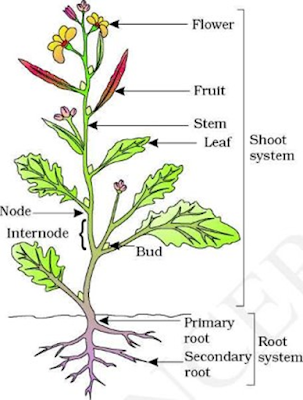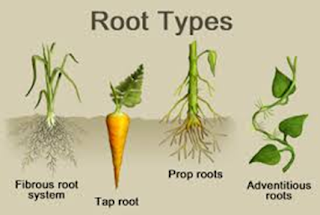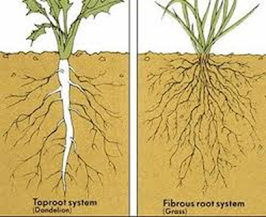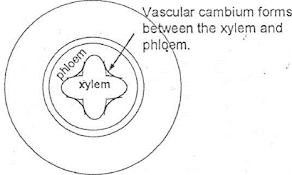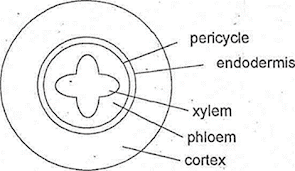A flowering plant are those plants which have roots, stems, leaves and whose reproductive structures are flowers. The roots of a plant are usually found underground. All the parts of vascular plants have an outer covering of protective tissue and an inner matrix of tissue within its embedded vascular tissue that conducts water, nutrients, and food throughout the plant.
A vascular plant is organized along a vertical axis, like a pipe. The part below ground is called the root; the part above ground is called the shoot. The root penetrates the soil and absorbs water and various ions, which are important for plant nutrition.
Roots
The functions of roots are:
Hold the plant in the soil and take in water and minerals from the soil. Water and minerals are carried upward to the stem and transport dissolved food downwards from the stem. In addition, the roots of some plants are specialised for storage of food.
The first structure to emerge from a sprouting seed is the primary root. As the plant grows and matures secondary roots develop which are affected by obstructions and other factors such as moisture and the chemical makeup of the soil. This results in irregular ways of root growth with frequent bends.
The two common systems of roots are the taproot and fibrous roots. When the primary root grows rapidly and remains the largest root in the root system, it is called a taproot system. Taproot systems grow deep into the soil and grow thick and fresh as in carrots, and oak trees.
A fibrous root system is made up of numerous roots, many of which are nearly the same in size as in maize and grasses. Sweet potatoes are fibrous root systems while carrot and beetroots are modified storage taproot. Adventitious root system grows from stems or leaves.
Root growth, internal structure and functions
The core of the root is the central cylinder or vascular cylinder that is surrounded by a layer of parenchyma cells called pericyclewhich is inside the endodermis. From the pericycle layer originate all secondary roots. Secondary growth in roots is similar to stems where annual growth rings are formed. At the centre of the vascular cylinder is where the conducting tissues- xylem and phloem are located. The pericyclic produces the cork cambium.
Behind the root cap is a region of actively dividing cells called the meristematic region. The cells of this region are small and thin-walled. This is where all the cells of the root are formed.
The ‘elongation zone’ comes after the meristematic zone. The cells that were initially made in the meristematic zone enlarge and push the root tip forward. Behind the elongation zone is the maturation zone or root hair zone where the cell differentiate. In both the root and the stem, cells develop into fully grown, functioning ceils of various types, such as xylem, phloem, and parenchyma.
A cross section through the maturation zone will show that the root is made up of several tissue layers. The epidermis is the outer most layers that are responsible in the taking in of water and minerals from the soil. Root hairs develop from the epidermal cells. These root hairs provide a large surface area for absorption of water. The cortex is just behind the epidermis. The parenchyma cells of the cortex store the plant’s food, which is mainly starch. The innermost layer of the cortex is called the endodermis and its main function is to control water into the central cylinder.
In the roots of woody plants, a vascular cambium develops between the xylem and phloem. The vascular cambium adds new xylem to its inside and new phloem to its outside.
Types of stems
There are basically two types of stems – herbaceous stems and woody stems. Herbaceous plants have soft, green, juicy stems that are called herbaceous stems. They have a life span of one to two years. The cells of apical meristems are the source of all the tissues of herbaceous plants. Herbaceous stems are produced by primary growth. Examples of herbaceous dicot include sunflower, buttercup, and alfalfa. The stems of a plant have several functions. Vascular tissue runs through the stem, transporting water, food, and minerals between the roots and the leaves. Some underground stems, such as the white potato tuber, are specialized for food storage.
The cactus stems are modified for storage of water and photosynthesis. The stems of strawberry plants have stems running along the surface of the ground and develop independent plants.
The shoot consists of stem and leaves. The stem serves as a framework for the positioning of the leaves, where most photosynthesis takes place. The arrangement, size, and other characteristics of the leaves are very important in the production of food in plants. Flowers, fruits and seeds are also formed on the shoot.
1. Internal structure of woody stems
Woody plants have woody stems that are made up of thick, tough tissue that you know as wood. There life span is usually more than two years.
All woody plants are dicots. The stems are tough because of the large amount of xylem that are kept on being added to the thickness of the stem. As shown below, round layers of wood increase the thickness of the stem as xylem builds on the inside of the vascular cambium. The phloem produced by the vascular cambium, does not build up. What happens is that its older layers break off and become new phloem.
1. Internal structure of herbaceous stems
The outermost tissue is the epidermis and is covered with waxy cuticle to prevent water loss. The vascular tissue is found in bundles that are arranged in a ring (dicots) or scattered (monocots). The central region of the stem is called the pith. Pith is made of parenchyma cells that store food.
 |
| Internal structure of herbaceous dicot stems |
The growth of new xylem during each growing season results in the formation of annual rings as shown below. Counting the rings can determine the age of a dicot plant. Growth each year is represented by an annual ring.
In young woody dicots, the centre of the stem is filled with pith. The cortex layer is inside the epidermis. For older woody stems, the cells of the pith die, and the cortex is replaced by phloem from the vascular cambium. The xylem lies next to the cambium.
The protective tissue, the bark, is the outermost layer of a woody stem. Bark is made of phloem, cork cambium and cork cells. The cork cells are made by the cork cambium. The inner, younger part of the bark is alive, but outer older part is dead tissue. The older outer bark cracks and comes off as new bark develops.
 |
| Structure of the protective tissue |
2. External structure of woody stems
At the tip of the plant is the terminal bud which is made of apical meristems enclosed by overlapping protective scales called bud scales. Within the leaf scars are dots called vascular bundle scars. These are the areas at which vascular bundles consisting of xylem and phloem passed from the stem into the leaf.
The axillary or lateral bud is found each leaf scar. These are found above the area where a leaf is or was attached to the stem. These buds may grow into new branches, or may remain small and dormant. Nodes are points along the stem where leaves and literal buds form. The space between two nodes is called an internode. Lenticels are holes that pass through the cork tissue which allows the exchange of oxygen and carbon dioxide between the atmosphere and the internal tissues.

